Sailing Guide: California to Hawaii (San Francisco, LA & Seattle)
Sailing from the U.S. West Coast to Hawaii can be a very enjoyable experience and plenty of sailors make the trip regularly. I was curious how to make the trip, so I did the research and this is what I came up with.
How to sail from California to Hawaii? First, sail southerly, following the coastline to 35°N-25°N (depending on the time of year). Then head westerly for Hilo. The best time for sailing is around June when the weather is good and hurricane activity relatively low. The trip will take you anywhere between 2-4 weeks. The sailing distance is about 2,500 nm.
Whether your boat is located in Seattle or San Francisco, the route is pretty much the same. But there are a couple of important things to know before departing. For example, the direct route isn't the fastest - not even close.

On this page:
General Sailing Route to Hawaii
Whether you leave from Seattle, Los Angeles, San Diego, San Francisco or even Oregon, your route will mostly be the same.
Route: Southerly to at least to San Francisco or Los Angeles latitude (38°N - 34°N), then head westerly for Hilo.
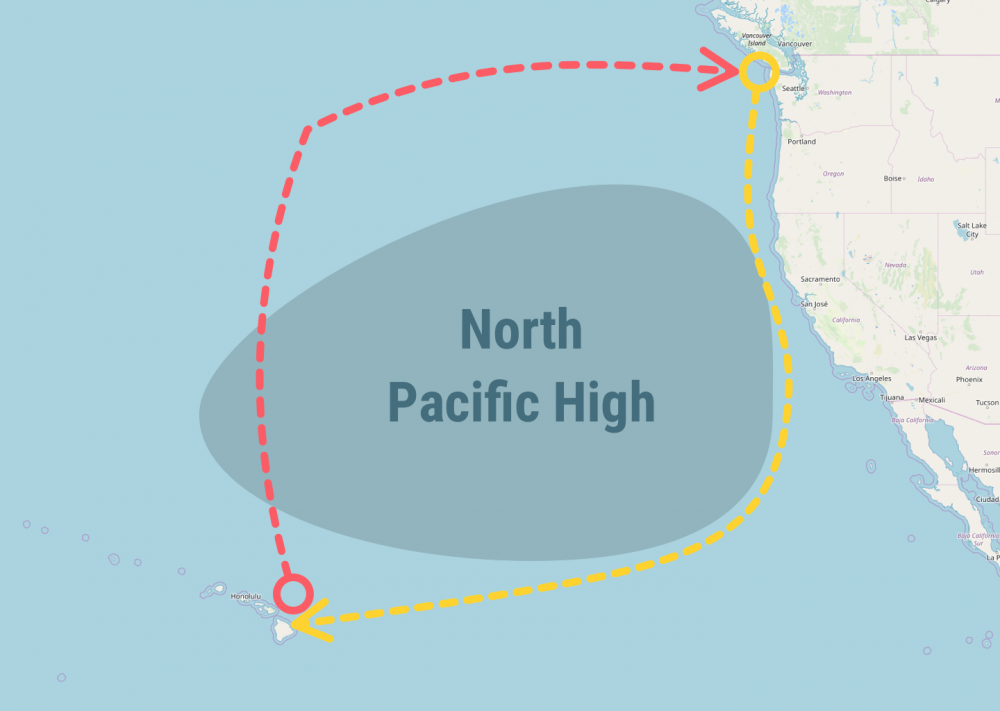
There are three ways to go about your southern trip.
- Slowest route: follow the coastline and hop from port to port until you reach San Francisco. Then head easterly.
- Fastest route: coastal sailing while following the coastline at about 20-40 miles out. This gives you a speed advantage because the coastal current and wind help you out.
- Safest route: offshore sailing at 50-100 miles out. Smoothest sailing but you run the chance of ending up in the Pacific High, which means you'll have poor winds.
Most people seem to agree that the further out you are, the safer it is.
Steering clear of the coastal waters is safer because the waters are smoother and there are way fewer vessels at even 50 miles out. This makes navigation a lot easier. When choosing for coastal sailing, make sure your navigation equipment is safe and sound. You'll have to deal with shipping lanes.
If you do follow the coastline, watch out for the following points - they can be dangerous:
- Cape Flattery
- Point St George
- Rocky Point/Honda Point
- Cape Blanco
- Cape Arago
Why do you need to go south?
You want to sail around the Pacific High. If you sail too far north you hit the Pacific High - light winds and rain.
The Pacific High is a semi-permanent depression in the North Pacific. It's the reason Hawaii has trade winds all year long.

How far south do you need to go?
In winter, the High shifts towards the equator and then back again north in the summer.
So the earlier in the year you leave, the more south the Pacific High is. Which means that the earlier you leave, the further south you'll need to sail to get a smooth ride.
A good rule of thumb is to:
- in winter: sail southerly to about 20°N
- in April - may: sail southerly to at least 30°N
- in summer: sail southerly to at least 35°N
Once you reach your southern edge of the Pacific High, turn westerly. It will take a couple of days to reach the tradewinds. From there on, it's smooth sailing all the way to Hilo.
So your route depends on the time of year. The biggest challenge of sailing to Hawaii is staying in the optimum wind zone. This zone is small. Inside of it, sailing is great and your Hawaiian cruise will be a trip to remember. Outside of the zone, this trip will get either boring or chaotic quickly.
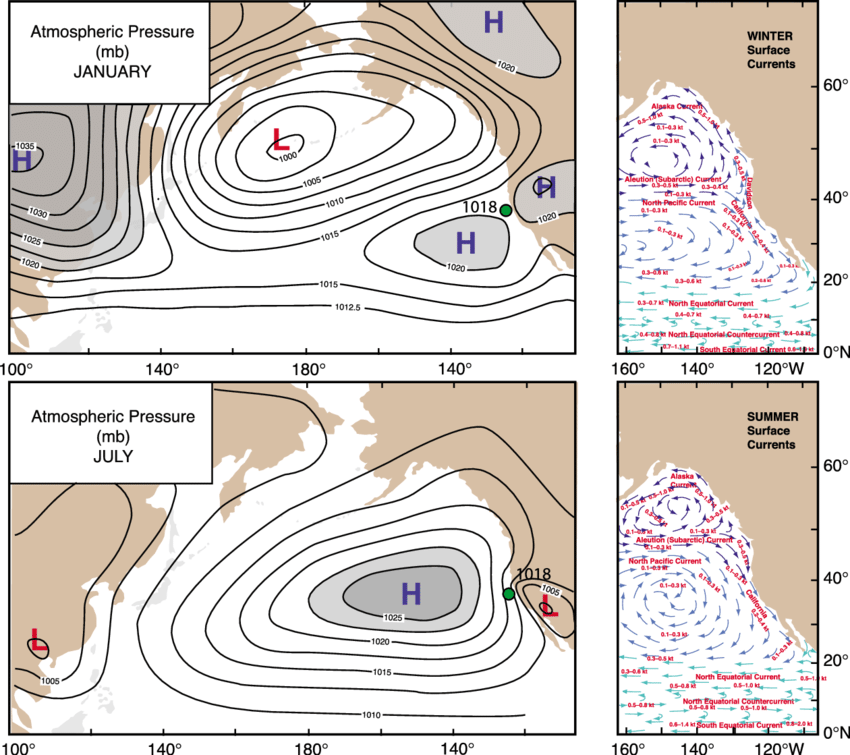
The best time to sail to Hawaii
So what's the best time to sail to Hawaii? The best time to sail to Hawaii is around June. The temperatures are comfortable in early summer, and the hurricane season still hasn't really started yet. In July you can encounter hurricanes. In April the southerly part of the trip can be quite cold.
The hurricane season in the North Pacific runs from June - November. I've read dozens of accounts and most sailors agree that hurricanes usually don't cause problems.
They are easy to spot way before they reach you, giving you plenty of time to prepare. Also, hurricanes tend to stay between 10°N - 20°N. The Pacific High ensures hurricanes don't creep up any higher. Hawaii is at 19 degrees north so you won't really get in hurricane territory.
The Journey Home
To get back, you essentially try to sail around the Pacific High.
Route: from Hilo, you sail northerly until you reach the northern edge of the Pacific High. This will most likely be around 47°N (Seattle latitude).
Then you turn easterly and sail to the coast. Once in range of the coast, you head southerly to return to your home base.
The sailing distance from Hilo to Seattle is roughly 2,600 miles. After that, add the following distances:
Sailing distances for the U.S. West Coast:
| From | To | Distance | From Seattle |
|---|---|---|---|
| Seattle | San Francisco | 660 nm | 660 nm |
| San Francisco | Los Angeles | 380 nm | 1,040 nm |
| Los Angeles | San Diego | 90 nm | 1,130 nm |
Specifics for Different Departure Cities
Below I'll discuss the specifics for the following cities:
- Seattle
- San Francisco
- Los Angeles
- San Diego
I'll discuss how long it takes to get there, and what the exact distance is in nautical miles for each point of departure.
Seattle - Hawaii
How long does it take to sail from Seattle to Hawaii?
It takes 4-5 weeks to sail from Seattle to Hawaii. It's roughly 3,100 nautical miles. At an average sailing distance of 100 nm per day (4-5 knots), it takes roughly 31 days to sail to Hawaii continuously. This is without any stops and under steady sailing conditions.
What’s the distance from Seattle to Hawaii by boat?
The sailing distance from Seattle to Hawaii is roughly 3,500 miles or 3,100 nautical miles. The direct distance is 2,550 miles or 2,215 nautical miles. However, the direct route isn't the fastest route because it runs through the North Pacific High, which has poor winds.
San Francisco - Hawaii
How long does it take to sail from San Francisco to Hawaii?
It takes roughly 25 days to sail to from San Francisco to Hawaii. It's roughly 2,500 nautical miles. High-performance boats may be able to reach Hawaii within 1-2 weeks. The exact time depends on your route. The best option is to head south to 20-25 degrees north (To make use of the trade winds) and then head west for Hilo.
What’s the distance from San Francisco to Hawaii by boat?
The sailing distance from San Francisco to Hawaii is roughly 2,500 nautical miles. The exact distance depends on your route. Most routes first follow the coastline south before heading westerly at 35°N - 25°N. If you'd sail in a straight line, the distance is 2,000 nautical miles.
Los Angeles - Hawaii
How long does it take to sail from Los Angeles to Hawaii?
It takes between 2-3 weeks to sail from Los Angeles to Hawaii. High-performance boats are able to reach Hawaii within a week. However, they are likely to sail a different, more challenging route. At an average sailing speed of 4 knots (which is usual), it will take 14 days.
What’s the distance from Los Angeles to Hawaii by boat?
The sailing distance from Los Angeles to Hawaii is roughly 2,600 nautical miles. Because of the Pacific High, most sailors first navigate southerly, before heading westerly at 35°N - 25°N. This increases distances but is faster than sailing through the Pacific High.
San Diego - Hawaii
I've previously written an article about how long it takes to sail from San Diego to Hawaii. You can read it here.
Spoiler: it takes between 2 and 3 weeks.
What's the distance from San Diego to Hawaii in nautical miles?
The direct distance from San Diego to Hawaii is 2,160 nautical miles. The sailing distance, however, ranges from 2,400 - 2,600 nautical miles. The exact distance depends on your route. The reason the sailing distance substantially longer is that you first sail southerly before heading westerly.
What the Journey Will Be Like
The start of the journey can be quite cold, especially at night. The sky is generally grey and cloudy.
If you catch the south-eastern edge of the North Pacific High you'll probably get wet. The winds here are poor and it will most likely be slow sailing.
However, if you stay on course you'll catch the trade winds soon enough, after about 4-5 days of sailing.
Once the trade winds are in your back, the air gets warmer and dryer. The sky will be clear and blue, as well as the waters. The next two weeks are a very enjoyable sailing experience. Most sailors agree that it's one of the most pleasant ocean voyages there is.
My Favorite Beginner Cruising Gear
For trips like these, I recommend using sound cruising gear. It doesn't have to be expensive. Here are my top 3 items:
- Chartplotter: Garmin echoMAP CHIRP 74cv (check current price at Amazon)
- Compass: Ritchie Navigation Explorer (check current price on Amazon)
- Backup GPS: Garmin Strike 4 (check current price on Amazon)
For more details on each one, head over to my recommended gear section.
Did you find the answer to your specific question?
👍 62 👎 5
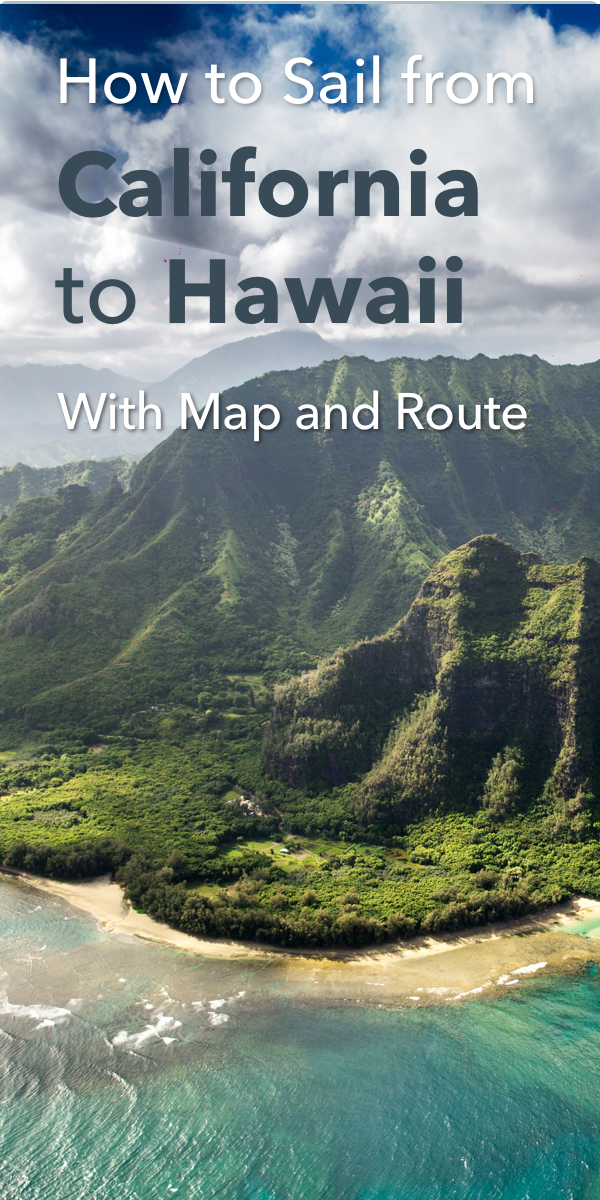
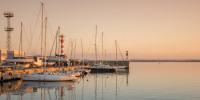
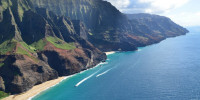
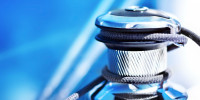
Comments
Shannon
This is great!! Still trying to make sailing my reality ❤️
Shawn Buckles
That’s great to hear, all the best to you!
Kéri Harris
Thanks for a very helpful summary. I am planning to make the trip in Dec 2020, so your winter synoptic snapshot is particularly useful.
Jeremy Merchant
Aloha Shawn! Great articles & information! My gf & I are looking at purchasing our first boat & sailing from San Diego back home to Kauai. A 26ft 1988 MacGregor. I saw that you wouldn’t recommend sailing anything shorter than 30. With that said do you think this trip in this boat would be a bad idea? Mahalo for your expertise insights!
Jeremy
Rachael
Hey Shawn!
I was 5 yrs old when we made the trip from Tiburon, Ca (Bay Area) to Santa Monica, then onto Hilo. We were onboard a 38’ DownEaster Ketch. Unfortunately, she didn’t have a I still have dreams about the trip. The dolphins, the stars and the flying fish that got stuck to the deck every morning! I would absolutely love to make the trip again as an adult!
Anyway, just wanted to say Hello!
Shawn
Hi Rachel! Hi to you too. Looks like a cool boat.
Shawn
Hi Jeremy,
You could definitely do it, I’ve heard plenty people making the passage in shorter boats. It could get a bit choppier though, that’s the reason for my recommendation.
Al
Anybody need a deck hand?
Jeff
Author very knowledgeable but the site so full of ads can’t read the text so will never use again.
Beth Ann Mathews
Shawn, My husband and I just began our discussion last night about whether to sail our Contest 44 to Hawaii. Your article answered all of our basic questions. I’m the limiting factor on such journeys, and I especially appreciate how you explain the big-scale pressure zones, prevailing winds, and currents and how they of course determine optimal routes. Thank you!
Norman D Campbell
This is not even what I asked. All I wanted to know was how much it would cost.
Greg
Hi Shawn,
I’ve been wanting to make the passage from San Diego to Hawaii for longer than I care to say. I’m expecting it to take roughly 21 days on an Alberg30. So what am I missing in your math? LA to Hawaii is 2600nm. You say 14 days at 4 knots. 2600nm / 4nm/hr = 650hrs. 650 hrs / 24hrs/day = ~27 days.
Leave a comment